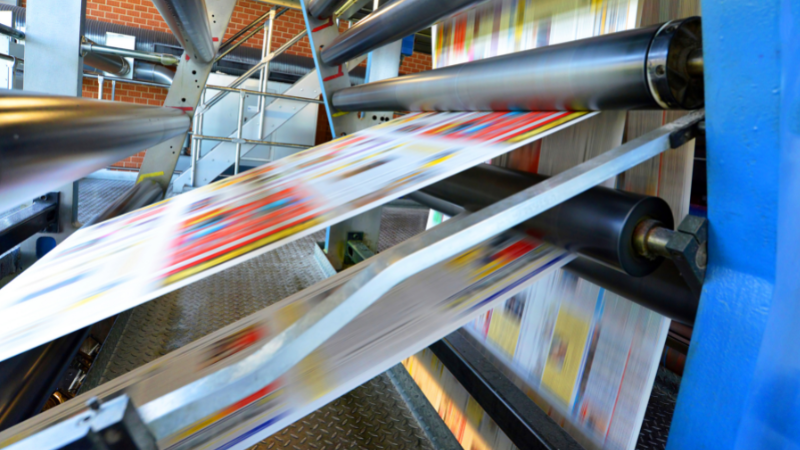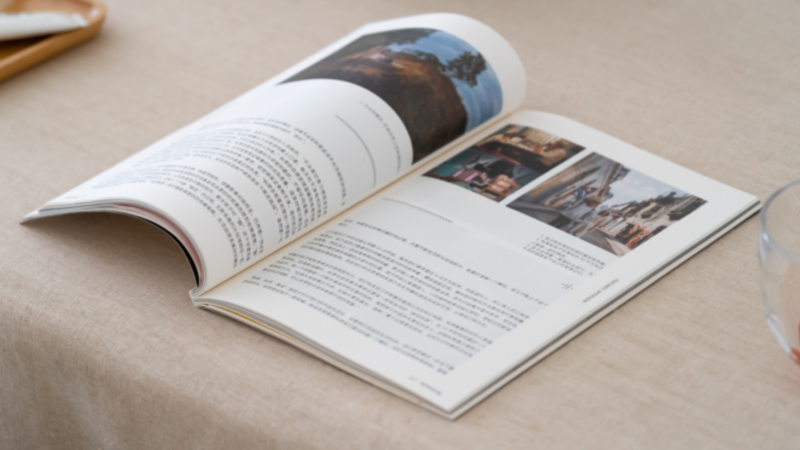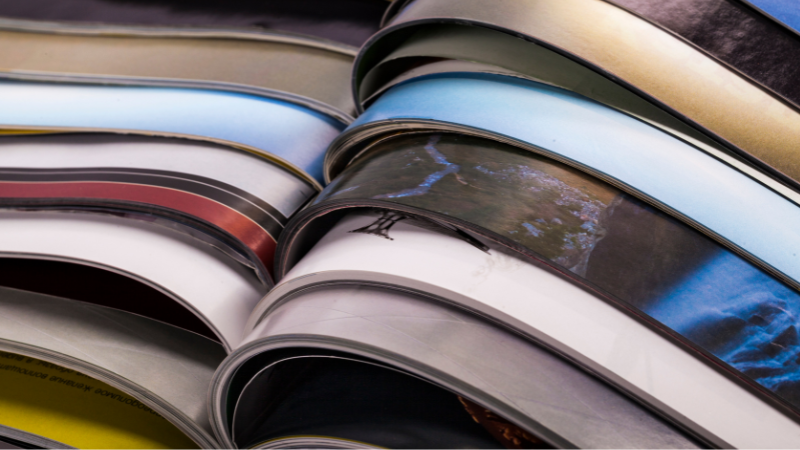Last Updated on April 19, 2024 by Packoi Team
In this article, you’ll read about creating a printed book. You’ll get ideas on what’s involved in every step so you can be sure that you’re doing the right things to create the book you’ve always wanted to publish.
Two Options to Print the Book
Before you get started on high-quality printing books, ask yourself: how will you publish your book?
You have two options. Each has its publishing process, but they’ll allow you to print high-quality books.
Let’s look at the two options you have for printing books.
Traditional Publishing
This option involves partnering with a publishing house to help print your book. This is an excellent option if you don’t know anything about the book printing process.

You can rely on the expertise and experience of the publisher to help you create the highest quality of books.
You’ll be paired with an agent when you work with a publisher. They’ll represent you and help you sell your printed book. They’ll help create your cover and format the pages.
While you are responsible for writing, editing, and proofreading your book, the book’s rights will belong to the publisher.
Self-Publishing Your Book
A self-published book means there’s no publishing house or agent involved. It’s just you taking care of everything involved in the book-printing process.
When you publish your book, you get to decide on the timeline, cover design, etc. You’re also responsible for financing all the expenses associated with publishing the book. That includes designing, editing, formatting, printing, etc. You can decide if you want to print on demand or in bulk.
But the great thing about this is you can enjoy total royalties and exclusive rights to your book. Of course, you’ll have to share the profit with the distribution channel. But the amount that’ll reach you will still be significant.
4 Things to Consider When Choosing Between Traditional and Self-Publishing
Choosing between working with a publishing house or self-publishing your book may seem harsh, especially if this is your first time publishing a book.

To help you decide, here are four things that you should consider to know which path to choose.
1. Distribution
If you get the help of a publishing house, they’ll take care of the distribution for you. Their connections will give your book a higher chance of reaching big bookstores. They’ll also help you get your book published online.
You’ll have to do your research if you publish the book yourself. It would be best if you approached book distribution sites, like Amazon, Barnes, and Noble, to sell your book. They’ll ask to share the profit with you as a fee for selling your book. Consider that when you set your book price.
2. Royalties
Publishers usually give authors an advance payment for their books. That means when the book starts to sell, the publisher will only give the author 10% – but only until after the advance is paid off. After that, the royalties can go up to 12.5%.
Self-published authors can take home a higher percentage than that. While distributors like Amazon will demand 60% of the book sales, you still get more than a publisher will give.

3. Publishing Costs
Working with a publisher is the best option if you don’t want to spend a dime on publishing costs. Then again, this is the reason why you don’t get a big part of your royalties. The publisher will get the prices back once your book starts selling.
So how much do self-publishers spend on publishing costs? It’s around $3,000 or more to produce the books. This includes editing, formatting, design, etc. This shouldn’t be a huge investment if you’re confident your book will sell.
4. Timeframe
It’ll take 1 to 3 years for your book to be published if you work with a publishing house. The back and forth of the approvals will eat up a considerable chunk of the process.
But if you publish the book on your own, you get to decide how fast or slow the process will go. If you focus on its creation, you can distribute your book in two months.
4 Benefits of Publishing Your Book
Self-publishing your book will take a lot of hard work. You are responsible for making sure that every page will captivate your readers.
But all of that is worth it. When you print your book, you can enjoy the following benefits.
1. You Have Full Control
Self-publishers have complete control over the decisions involved in printing their books. From the book price and print quality to the paper stock and the book cover’s design, it’s all up to you.
That also means you are responsible for creating the highest quality book. Whether you get the text, you want or not – that’s up to you.
Although you control the creative and technical side of printing the book, you can always get expert advice.

2. You Can Publish Your Book Faster
Since you control the timeline and the decisions, self-publishing your book will allow you to expedite everything. You can shorten the publishing process. Instead of taking years, you can choose a print-on-demand approach.
That way, you won’t be bothered with boxes of your book. Please leave it to the printer to send the text to the reader who ordered it.
You can have the book in the hands of the reader in no time.
3. You Get All The Earnings
While you have to share the profit with the distributor for every book sold, you’ll still get a more significant portion than when you work with a publisher.
You also control the price of the book, not the publisher. So if you want to give a discounted price, that’s your decision.
4. You Can Increase Your Connections
Taking care of the book printing yourself will also benefit you. You’ll increase your connections in the industry.
You’ll know who to contact if you decide to publish another book. You already have contacts to help you with your next printing project. You could even develop valuable professional relationships for future endeavors.
16 Steps to Self-Publish Your Book
If you’re sure that you want to self-publish your book, you have to make sure you meet the industry standards. That way, you can easily find readers who want to pay for your book.

To help you publish a high-quality book, here are the steps you must thoroughly go through.
1. Write the Book
This is the obvious first step. Write your book from cover to cover and go through every page.
Create a document and start with a plan or outline of the book. List in bullet points what you want to write. Once you’re happy with the design, start writing your first draft.
2. Edit the Content
After you’ve finished writing, it’s time to go back and edit them.
Improve and make revisions until you like the content that you’ve written. Keep going until you’re happy with what you’ve written.
It would be best if you also asked someone to edit the book. Having a new set of eyes will help you spot mistakes you may have missed. You could track the changes made if you wrote your book on Microsoft.
3. Get the Legalities In Order
Before you print your paperback or hardcover books, get all the legalities in order first.
Apply for the ISBN or International Standard Book Number, that’ll make your book unique. If you’re in the US, you should apply for the LCCN or Library of Congress Control Number. If you’re in another country, find the alternative number you should get.
Apply for the copyright as well. That way, you can protect the contents of your book and secure it as your property.

4. Choose Your Book Size
The next step is to choose the trim size. This refers to the size of the book. Most book printing companies offer different sizes. Make sure you consider the size of your book based on what type it is.
It would be best if you also thought about the cover. It’s okay to have a small paperback book, but if you want a hardcover, you might want to make the size a bit bigger.
5. Decide On the Cover
The cover of the book comes next. Your choice will depend on the contents of your book. A coffee book may be better off with a hardcover. But if you want to publish a novel, a paperback will do.
Note that the cover will play a role in selecting the right binding style for your book.
6. Pick Your Binding Method
Usually, when you know the book’s cover, it’s easier to choose among the binding options.
So if you have a paperback, you should use the Perfect Binding method. If you want a hardbound book, choose the case-bound method.
You should also take into consideration the page count. It would be best if you had a binding style with the correct spine width to accommodate the pages of your book.

7. Determine Your Paper Type and Ink Options
It’s always best to check the paper stock of the printer. If they can use it and still produce the high-quality printing you want for your book, you might get a discount on the cost.
Make sure you consider the type of book you’re printing and the number of pages when deciding on the ink and paper type options.
Having many pages means choosing thinner paper so the book isn’t too thick or heavy.
8. Format the Typeset
The typeset is all about the visual text format. You’ll lay out everything to know the book’s page count.
However, the typeset will look like what you’ll get for the proof copy. Consider that as you lay out the typeset for the pages of your book.
9. Design the Book Cover
The cover artwork is next for your book design. You can get a graphic designer to help design the front and back cover.
Make sure you specify if you want a softcover or hardcover book. The materials for these covers are different. That means the print design quality will also come out differently.

10. Put Together a Marketing Plan
At this point, you should consider the marketing plan for your book. How will you get online retailers to sell your book? Will that require you to print your books in bulk, or will a print-on-demand service suffice?
Your marketing plan will help you forecast how many books you have to print for sale.
11. Find the Right Printer
When you’re looking for a printing company to work with, ask about their services. Do they offer print-on-demand and shipping, too?
Most printers will also ask you how many books and pages you order. You have to meet the minimum orders so they can give you a reasonable price.
12. Finalize Your Retail Price
Once you’ve negotiated the binding and printing cost with the printer, you’ll find out how much you need to invest. You can finalize the details of the book more easily – including the number of pages, the paper type, and even the price you can set for selling the book.

13. Proofread Your Work
Before you give your book to the printer, you need to proofread your work. Sometimes, you only get one proof copy—usually a paid copy.
So go through the pages of your book before you ask for proof copies from the printer. The test print will also give you an idea of the print quality.
14. Print the Book
Once the proof copy and the book cover are approved, you can go ahead with the book printing in bulk. Or you can only print a few books. This is the beauty of self-publishing your book. You’re free to decide how you want to print.
15. Distribute the Book
When you self-publish, you’re in charge of the book distribution. You can go for online to of your book.
If you don’t have space to store boxes of books, opt for a print-on-demand service. The printer will print only when there’s an order, and they’ll also send the book out.
All you have to do is market your book.

16. Keep Marketing Your Book
Finally, once your books are selling, keep marketing them. That way, you can convince other readers to buy more books.
Create a website and social media page to promote your book.
If you get a lot of followers, you can consider publishing an ebook version.
Printing Your Book? Packoi Printing Can Make the Process Easier
Book printing as a self-published author is not an easy feat. But if you partner with the right printing company, you can get the right quality for the book that you want to sell.
If you’re looking for the right partner to produce your book, get in touch with Packoi Printing. We can help make the printing process more accessible.
Let us know the details of your book, and we’ll give you a fair quote in no time.




